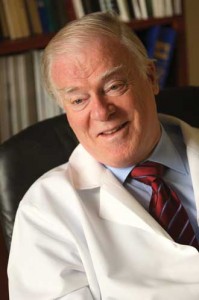
Habs physician cut his teeth stitching up Redmen
By Jim Hynes
Sports medicine has come a long way since Dr. David Mulder started treating the wounded warriors of the McGill Redmen hockey and football squads back in 1963. And Mulder has come a long way, too. The young medical resident and sports fan who signed on to tend to the cuts, bumps and bruises of his fellow McGill students is now the Chief Physician for the most famous team in all of hockey, the Montreal Canadiens.
Through it all, Mulder (MSc’65) has remained intimately tied to McGill. Currently Chief of Thoracic Surgery in the Department of Surgery at the MUHC and a professor in the Faculty of Medicine, he also served long stints as both Chief of Surgery and Chair of the Department.
When Mulder enrolled in McGill’s residency program in general surgery in July 1963 after getting a medical degree in Saskatoon, there really was no such thing as sports medicine. His first exposure to treating injured athletes came when Dr. Douglas Kinnear, his mentor and predecessor with the Canadiens, asked him and two of his fellow surgical residents if they would help out with the McGill hockey and football teams as well as the Montreal Junior Canadiens, “suturing up cuts and dealing with bumps and bruises,” Mulder said. “And we really enjoyed it because they paid us $10 a game… for the Junior Canadiens anyway.
“It wasn’t something I set out to do, not at all,” he said. “But it was something where I was glad to get the opportunity, I have to admit. And then one thing led to another.”
A two-year stint pursuing studies in cardiothoracic surgery at the University of Iowa aside, Mulder has managed to keep one foot in a hockey dressing room ever since. He took care of the Canadiens’ American Hockey League affiliate Voyageurs in the lone season they played in Montreal, and then seconded Kinnear, the acknowledged dean of pro sports doctors, with the Canadiens many years before succeeding him as the team’s Chief Physician in 1999.
“I really enjoy it,” Mulder said of working with the Canadiens. “It’s an avocation, a release from what I do here at the hospital every day. It’s certainly very enjoyable.”
Mulder cites the introduction of helmets as the biggest change he has seen over his many years in hockey, at least from a medical perspective.
“When I worked for the Junior Canadiens the big thing was how fast you could sew up a facial cut – Dr. Kinnear used to call us the cut men. Then, with helmets and facemasks, cuts and eye injuries disappeared completely with junior players and concussions virtually melted away,” he said. “It’s a different time. On a relative basis, concussions are actually a surprisingly small problem now compared to what they were back then. But we hear more about them now because of reporting.”
While the number of head injuries has diminished, Mulder and his colleagues are faced with an increasing number of injuries to the abdominal wall, something that may have been dismissed as a “groin pull” in the days of “old time hockey.”
“And we don’t understand them all. I’ve noticed how well-conditioned the athletes of today are, and the two might be related. They’re bigger and heavier and move faster. And with all the muscle training they do…when the muscles are fully loaded and they get checked, that’s when they get hurt. That’s one theory anyway.”
Luckily, new technologies have revolutionized the diagnosis and treatment of injuries to muscles and ligaments. Doctors now have imaging technologies like CT scans and Magnetic Resonance Imaging (MRI) at their disposal.
“Those are things we never even dreamt about a few years back,” Mulder said. “Now we can do an MRI of a groin and see a torn muscle where before we used our clinical judgment. Now we can virtually tell you how many strands of muscle are torn.”
Today, with sports medicine an increasingly popular area of study at McGill, Mulder has no trouble finding volunteers to help him treat his star patients.
“We have lots of medical students and residents who want to shadow me because they have a chance to go down to the Bell Centre,” Mulder said. “I think it’s a good exposure to learning about sports medicine. Every hockey game we have a surgical resident who comes down with us, just like I started out a long time ago.”
And, getting to the important stuff, just how bad is André Markov’s knee?
Sorry. Doctor-patient confidentiality.
